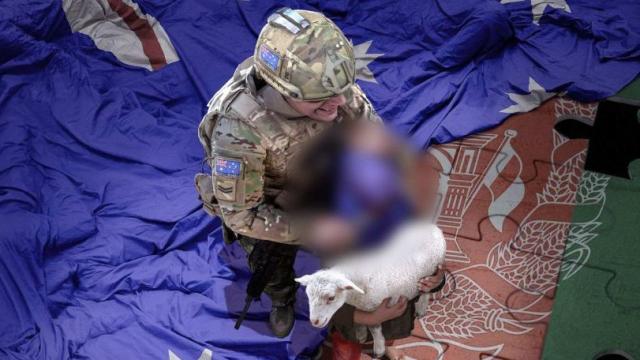The image depicting a fictional Australian soldier holding a knife to a child’s throat tweeted by a diplomat from China can be called many things: art, propaganda, even in poor taste. But here’s one thing it is not: disinformation.
Yesterday, China’s Foreign Ministry spokesperson Zhao Lijian tweeted “Shocked by murder of Afghan civilians & prisoners by Australian soldiers. We strongly condemn such acts, &call for holding them accountable.”
The tweet was accompanied by the now-infamous image (which includes the English text “Don’t be afraid, we are coming to bring you peace!”) reportedly created by a Chinese artist Crowd Kylin.
His tweet was referring to the incidents investigated in last month’s Brereton report, which credibly claims Australian soldiers committed dozens of war crimes in Afghanistan including the murder of innocent civilians.
This, of course, comes amid rising tensions with China and as China’s diplomats have begun to use the platform to push their country’s narratives (and occasionally like a porn video).
The response from the government was swift. Just hours after it was posted, Prime Minister Scott Morrison came out and condemned the tweet in a press conference and called on China to apologise.
Australia’s Foreign Minister Marise Payne gave China a spray and called the tweet disinformation.
“It is an appalling, outrageous and disgusting piece of social media … it is the most egregious example (of disinformation) that I have seen in my time in the parliament,” she said according to the ABC’s Stephen Dziedzic.
FM @MarisePayne lets loose at China’s Foreign Ministry, and labels Zhao Lijian’s tweet “disinformation”- “it is an appalling, outrageous and disgusting piece of social media … it is the most egregious example (of disinformation) that I have seen in my time in the parliament”
— Stephen Dziedzic (@stephendziedzic) November 30, 2020
And former Australian foreign minister Alexander Downer called on Twitter to take it down, too.
Twitter took down @realDonaldTrump tweets it didn’t like. We Australians expect it to take down deeply offensive Chinese Communist tweets
— Alexander Downer (@AlexanderDowner) November 30, 2020
But here’s the thing: it’s not really disinformation.
Disinformation is generally defined as content containing false information that’s knowingly created in order to deceive.
This isn’t really that. While not proven in a court of law, an independent investigation commissioned by the Australian Defence Force has found enough evidence to publish a report saying so. The army has subsequently told 13 soldiers they face dismissal over the report.
This tweet refers to that fact and includes a graphic but clearly fictional depiction of the awful acts. The image is clearly an artwork — no reasonable person would see it and believe it is a photograph of a real event.
The artist who claimed to be behind the artwork, Wuheqilin, is well known for his nationalist, violent artworks depicting scenes set in the West.
Now, there’s many reasons to disapprove of this tweet, not least China’s rank hypocricy given its woeful human rights record including the mass detention of Uyghur Muslims.
However, that doesn’t make it disinformation. Words matter!
Complicating it further, there is some data that suggests there might be some internet skullduggery afoot.
As first spotted by Australian Strategic Policy Institute analyst Ariel Bogle and dug into by QUT’s Tim Graham, many of the accounts that have engaged with these tweet are new accounts created in the past 24 hours in China.
OK, I’ve collected as many replies to @zlj517‘s tweet as I could (10,059 replies sent by 8,605 accounts).@arielbogle spotted newborn accounts jumping onto the reply bandwagon, and this diagram provides further evidence ????
(thread below) pic.twitter.com/WyPEextJdZ
— Tim Graham (@Timothyjgraham) December 1, 2020
This isn’t the smoking gun of some foreign interference per se. Newly created accounts can suggest there is some platform manipulation happening, but it’s far from conclusive evidence.
The fact that Twitter is blocked in China complicates this further.
Navigating this distinction isn’t made any easier by Australia’s top diplomat calling something disinformation when it’s not. Ironically, falsely claiming something is fake news is something that authoritarians love to do!
Australia’s reckoning with the war crimes reported in the Brereton report should be uncomfortable. It found reason to believe terrible acts of violence were committed in our country’s name. And it doesn’t help when China is the one needling us.
Calling this tweet disinformation from China denies the truths our country has to come to terms with.
